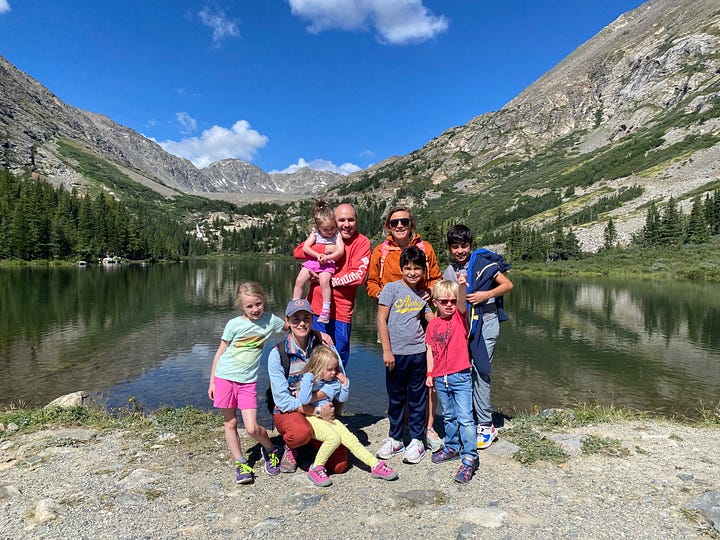Thwarting Hedonic Adaptation
What the science of well-being teaches us about how to hack our biology and want the right things
I recently started taking the course the Science of Well-Being with Professor Laurie Santos. Santos launched the class in the spring semester of 2018 as an early observer of the American mental health crisis (now shown throughout the Anglosphere).
Santos was concerned about the data she was seeing and the diminished well-being of her students, so she wondered if she could build a course based on scientifically proven methods to foster well-being — would it help?
She expected around 30 students to enroll. Over 1200 did—about a 1/5 of the undergraduates at Yale. Clearly, there was a demand.
Santos covers a wide range of material in the course — and I’ll spend some time in the coming weeks in this space unrolling some of that learning. But up first is a science-based approach to thwarting one of the biggest personal challenges we face in the 21st Century—the problem of adjusting to an environment of Too Much — aka hedonic adaptation.
Hedonic adaptation is the psychological tendency to return to a personal baseline level of happiness. It is the phenomenon we experience when we have an initial emotional response to a new experience or change, followed by a gradual return to our baseline emotional state. In essence, it describes the tendency for humans to habituate to changes in their circumstances, leading to a consistent level of subjective well-being regardless of the events or material gains they encounter.
The idea is that we adapt—quite easily—to environments of abundance — so much so that the thing we felt we had to acquire to achieve happiness losses its glimmer rather quickly.
This phenomenon often leads to the "hedonic treadmill," where our pursuit of pleasure and acquisitions becomes a never-ending cycle of temporary highs and eventual return to baseline contentment.
No matter how much we accumulate or accomplish, the thrill fades, and we find ourselves searching for the next source of happiness.
But what if there was a way to break free from this cycle and find lasting satisfaction in our lives — with the things we have and the moments we experience?
Hacking Our Biology to Want the Right Things:
Here’s the hit list that Santos offers for the path to reorienting our thinking patterns. The things we can train ourselves to do in order to thwart hedonic adaptation.
Practice Gratitude: Our evolutionary history wired us to focus on what we lack rather than what we have (we are designed for environments of scarcity, not abundance). Practicing gratitude is a great tool to counteract this bias. By consciously acknowledging and appreciating the positives in our lives, we can recalibrate our mindset to recognize the abundance we possess.
Social Connections: Humans are inherently social creatures, and our well-being is deeply intertwined with the quality of our relationships. Cultivating meaningful connections with friends, family, and communities not only provides emotional support but also contributes to a sustained sense of happiness. The number of strong social connections we report to have correlates with our overall levels of happiness.
Savoring Experiences: In a world fixated on material possessions, savoring experiences can break the cycle of hedonic adaptation. Experiences provide lasting memories and contribute to a sense of personal growth, offering a unique way to derive happiness that doesn't fade as quickly as material acquisitions.
Mindful Consumption: The modern world bombards us with messages that equate material possessions with happiness. Practicing mindful consumption involves being intentional about our choices and recognizing when we're chasing short-term gratification at the expense of long-term well-being. (The stoics would tell you that before you acquire anything, ask yourself: Is this necessary? Most of the time, the answer is no. Remind yourself that the thrill of that new item will fade quickly after you make a purchase. You’re better off spending your resources on experiences — things designed to end — that don’t stick around making you bored of them.)
Pursuit of Meaning: The pursuit of meaning and purpose in life transcends fleeting pleasures. Engaging in activities that align with our values and contribute to the greater good offers a deeper and more enduring form of fulfillment.
Savoring
As part of the course, we are required to practice different techniques like the ones outlined above for weeks at a time—with intention. The intention is important because these ways of thinking are not our default mode — especially in our contemporary environment.
It requires actively engaging our minds to do these things if we want to see the benefits. (It’s like going to the gym for our minds … and just like the real gym and keeping up with your fitness, there is no last rep).
For me, so far, savoring is the technique at the top of the list — and I’ve had the chance to practice a lot of it in the last couple of weeks.


We took a family trip to Colorado at the beginning of the month, and what a place to savor. From the mountains to the snow-melt-fed creeks to the time to slow down and really pay attention while outdoors with family in nature. It was just the best.
The kids also all started school this week. It’s a joy watching them grow, learn, and become more complete versions of themselves.
In these days, I’ve been doing the reps for savoring — the techniques that enhance your present moment and create the mental pathways for long-lasting satisfaction.
Here are some tricks from Santos on fully embracing the art of savoring:
Slow Down: Here is where ideas of mindfulness come into play. Some things just take the time they take (to quote the great Oliver Burkeman). Instead of trying to hurry through or rush to the next thing, just observe yourself being in that moment (almost imagine a bird’s eye view of what you are experiencing). When we cast aside the desire to move through things quickly, we transform our experiences. The meal tastes better, our conversations are deeper and richer, landscapes strike us in a different way. We notice the things we so often miss. We can say to ourselves: how lucky I am to be in this moment. To have this moment at all is a gift.
Engage Your Senses: This one is nested under slowing down — or is a strategy for slowing down. Attuning yourself to the sensory experience you are in fundamentally shifts your experience into a richer one. From a neuroscience perspective, when we dial into the present we engage our sensory memory — increasing the likelihood that the experience is imprinted more deeply into our subconscious, we activate our emotional resonance, and we create a neurotransmitter release of serotonin. If we want to find more awe in everyday things — slowing down and engaging our senses is the way to do it.
Share the Experience: As social animals, we are wired for connection with others. When we share the joy of our experience, we not only amplify the experience for ourselves, we also amplify the experience for others. Literally, say to the people you are having the experience with how grateful you are to have that experience. Say, out loud, “This is awesome,” “Isn’t this wonderful,” “I love this," “I love having this experience with you,” etc. When we communicate our joy with others, when we express gratitude and awe with others — we not only improve our own well-being, we also improve the well-being of those we care about.
The great writer Audre Lorde puts it this way:
The sharing of joy, whether physical, emotional, psychic, or intellectual, forms a bridge between the sharers which can be the basis for understanding much of what is not shared between them, and lessens the threat of their difference.
…
That self-connection shared is a measure of the joy which I know myself to be capable of feeling, a reminder of my capacity for feeling. And that deep and irreplaceable knowledge of my capacity for joy comes to demand from all of my life that it be lived within the knowledge that such satisfaction is possible.
…
For once we begin to feel deeply all the aspects of our lives, we begin to demand from ourselves and from our life-pursuits that they feel in accordance with that joy which we know ourselves to be capable of.
Keep looking for connection,
The Three Chairs
“I had three chairs in my house; one for solitude, two for friendship, three for society.” -Henry David Thoreau, Walden My previous two posts focused on setting the frame of our cultural struggles as we allow our technological tools to transform us; this piece is about solutions. The first of those solutions is the healing power of conversation.
Attending
I’ve written a lot about why I believe having our attention stolen is so destructive. Today, I want to discuss why holding our attention is so important. This past Saturday, I was in the presence of a remarkable man, professor, and author Belden Lane. Belden spent the last 36 years as a professor at Saint Louis University and is the other of a number of …





